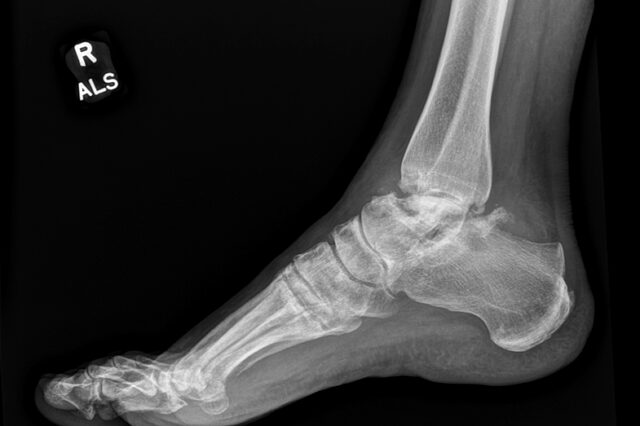3D Printing of Replacement Talus Bone Potential Boon for Patients
The talus bone, all of two-inches long in adults, packs outsized influence in the mechanics of the foot and ankle. It’s among the human bones with the highest…

Update your location to show providers, locations, and services closest to you.
If you're experiencing foot or ankle pain, you're not alone. Many people suffer from conditions that can cause discomfort and difficulty moving around. At UF Health Orthopaedics, our team of expert foot and ankle surgeons, sports medicine doctors and podiatrists are dedicated to providing top-quality care to help you get back on your feet.
As the only orthopaedic center in the area with multiple fellowship-trained foot and ankle orthopaedic surgeons, we provide comprehensive treatment plans that help many patients with a variety of conditions. From common athletic injuries to advanced reconstructive surgeries, we are here to help you get back in motion. We also have an expertly-trained podiatrist available to tend to your personal podiatry needs.
Our foot and ankle doctors are committed to exemplary patient care, training the next generation of doctors and continual research to advance the field of foot and ankle medicine. We offer state-of-the-art techniques, technologies and facilities to provide comprehensive treatment plans — from conservative options to surgical care. Whether you need surgery or non-surgical treatment, we have the knowledge and resources to help you find relief. We understand that every patient is unique, and we will work with you to create a personalized treatment plan to meet your specific needs.
UF Health Orthopaedics provides a comfortable and welcoming environment for our patients. We want you to feel at ease during your visit, and our team will do everything we can to make sure you have a positive experience.
Conditions we treat:
Procedures we perform:
As one of the region’s top destinations for orthopaedic care, UF Health Shands Hospital has made a distinguishable mark in the treatment of musculoskeletal issues, and the realm of foot and ankle is no exception.
Common ankle and foot conditions include the following:
Using a tiny camera called an arthroscope as well as other surgical tools, physicians can inspect and repair the tissues inside or around your ankle, and that includes cartilage, bones, tendons and ligaments.
The benefit of this method is the ability to spot and correct ankle issues with a minimally invasive approach. As a result, an ankle arthroscopy can produce less pain, stiffness and complications, while also requiring less recovery time as compared to open surgery. Still, open surgery may be recommended for those with a lot of damage.
Learn more about Ankle Arthroscopy.
Damaged cartilage does not heal itself effectively, which has pushed doctors to introduce innovative surgical techniques to stimulate the growth of new cartilage around joints. Many of these restoration procedures are done arthroscopically with small incisions, but some require more open incisions. This is especially true if other issues related to the joint need to be treated, such as a ligament tear.
Some of the procedures most frequently performed to restore cartilage are microfracture, drilling, abrasion arthroplasty and autologous chondrocyte implantation, among others. The goal of these procedures is to decrease pain and improve function, while also postponing or even preventing arthritis.
Bunions are characterized by a bony bump that forms on the joint at the base of the big toe, which points toward the second toe. This condition can run in families and is more common in women than men. Bunions can also develop over time from wearing narrow-toed or high-heeled shoes.
The extra bone and fluid-filled sac at the base of the big toe can lead to corns, calluses, pain in the joint and decreased movement in the toe site.
Surgery may be suggested in cases where the bunion becomes more painful. For example, a bunionectomy removes the bony bump and realigns the toe. However, more than 100 different surgeries are available to treat bunions.
Deformities in any area of the body can lead to pain and other issues. There are specific types associated with feet, such as club feet, hammer toe or extremely flat feet or high arches.
Foot deformities can be congenital or acquired. Some deformities don’t cause pain and don’t require treatment.
As is the case with bones in other parts of the body, ankles and feet can suffer a stress fracture (sometimes referred to as a hairline fracture) or complete fracture.
Although treatment for a broken ankle or foot can depend on multiple factors, some fractures are severe enough to require surgery.
A deformity of the toe, usually the second toe, in which it’s bent downward in a claw-like position is called hammer toe.
This condition can be congenital or it can develop over time, usually from wearing short, narrow shoes that don’t fit well. Hammer toe leads to muscles and tendons in the toe becoming tighter and shorter. For the rare case where all toes are affected in this way, it may be due to a problem with the nerves or spinal cord.
Severe cases of hammer toe can benefit from surgery, which will help to straighten the joint. In most instances, the operation would involve severing or relocating tendons and ligaments. Other times, the bones on either side of the joint must be fused together.
One common orthopaedic-related issue in the feet is joint pain or arthritis, which is inflammation of one or more joints that leads to pain and stiffness.
Many things can give rise to joint pain, such as arthritis, bursitis and muscle pain, but other culprits include tendinitis, injuries, infections or gout.
Learn more about joint pain.
Learn more about arthritis.
Various ligaments and tendons help to hold your ankle and foot together. The outside of an ankle is comprised of lateral collateral ligaments (LCL), while the inside of an ankle is made up of medial collateral ligaments (MCL). If these ligaments are severely stretched or torn, surgery may be needed to regain stability.
Ligament reconstruction surgery may involve repairing the ligament itself or harvesting a tendon — and possibly rerouting it — to take the place of the damaged ligament.
While heel pain is a common ailment, sesamoiditis represents complications in the forefoot, specifically under the big toe.
The sesamoid bones, comprised of two very small bones that can be found under the big toe joint, are burdened by significant pressure in the process of walking because of where the bones reside.
Although treatment for sesamoid-related issues don’t involve surgery, a physician may suggest removing a sesamoid bone if other methods fail.
One of the most common musculoskeletal injuries seen by orthopaedic providers are sprains, which occur when supporting ligaments are stretched or torn.
Based on the damage to the ligaments, which can suffer small tears or complete tears, ankle sprains can be either mild or severe. Ankle sprains frequently happen as a result of a twisting motion during physical activity. The injury can cause swelling, tenderness or bruising.
This condition is characterized by excessive compression or pressure on the posterior tibial nerve, which is located on the inside of the ankle. This nerve is one of the key structures that lies in the tarsal tunnel, a narrow space that contains not only nerves, but also arteries, veins and tendons.
Tarsal tunnel syndrome is accompanied by symptoms that may include an abnormal sensation like burning, numbness or tingling. Other symptoms may arise like pain in the bottom of the foot and toes or weakness of the ankle, foot muscles or toes.
Tarsal tunnel syndrome is likened to carpal tunnel syndrome in the wrist since both disorders stem from a compression of a nerve in a tight space. At times, surgery can be an option to enlarge the tarsal tunnel or transfer the nerve, which can help reduce pressure on the tibial nerve.
Learn more about tarsal tunnel syndrome.
Also known as total ankle arthroplasty, this surgical procedure involves using artificial joint parts (prosthetics) to take the place of a patient’s bones when he/she may have badly damaged bone and cartilage in the ankle joint.
Main causes of this damage are arthritis (as well as osteoarthritis and rheumatoid arthritis), fracture, infection or a tumor. Past ankle joint infections may preclude a patient from being a candidate for a total ankle replacement. A successful operation is likely to decrease or eliminate pain, while adding range of motion to the ankle, especially vertically.
Learn more about Ankle Replacement.
Due to the well-documented complexity of the total ankle replacement procedure, with results still not up to par with that of hip and knee replacements, it is common to expect total ankle replacement to require secondary procedures. These are often called “revisions” or “reoperations”.
In a total ankle revision, surgery may be done to replace or compensate for a failed implant or to correct undesirable scars or scar tissue stemming from a previous surgery.



The talus bone, all of two-inches long in adults, packs outsized influence in the mechanics of the foot and ankle. It’s among the human bones with the highest…
